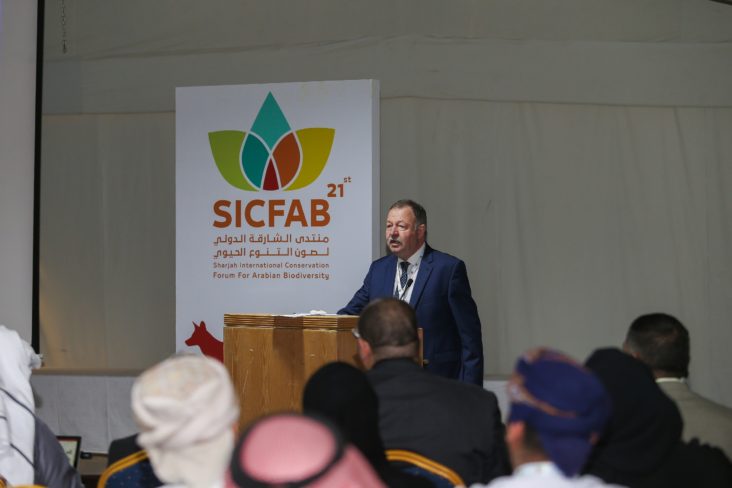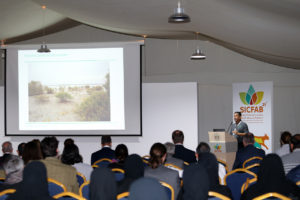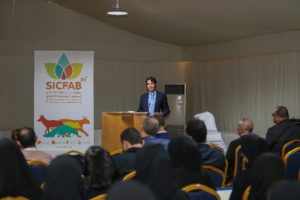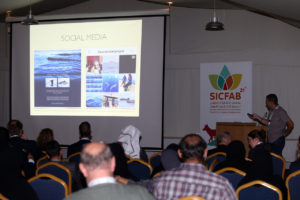Current Status And Future Conservation Challenges And Solutions For Coastal And Marine Ecosystem In Focus At 21st SICFAB

Growing prosperity and an increasing population in the Gulf states is taking a heavy toll on coastal and marine life, stated Mr. Fareed Krupp of Senkenburg Research Institute and Museum of Nature, Germany at the 21st Sharjah International Conservation Forum for Arabian Biodiversity, SICFAB.
Organised by the Environment and Protected Areas Authority, EPAA, SICFAB, which convened on February 3rd – at Desert Park in Sharjah will run until February 6th. Opening the forum with an introduction to key themes, Mr. Krupp highlighted the current status and future conservation challenges for coastal and marine biodiversity. The key marine ecosystems include soft and hard bottom subtidal habitats, mangroves, salt marshes, coastal wetlands, seagrass, macroalgal beds, coral assemblages and reefs among many others.
In the session Mr. Krupp highlighted marine environments, marine ecosystems, pressures and threats, conservation needs, current infrastructure, challenges and opportunities.
“Marine and coastal biodiversity is of paramount importance. However, habitat destruction, overfishing and pollution, have resulted in the deterioration of the marine ecosystem, which if not controlled will lead to the marine and coastal ecosystem losing its capacity to provide the benefits people have relied on for millennia – food, livelihoods, and climate regulation,” said Mr. Krupp.
According to Mr. Krupp, the key factors that pose threats to coastal and marine biodiversity are urban, industrial and tourism developments. In his opinion, dredging, landfill, disposal of solid waste and sewage discharge, oil spills, pollution from aquaculture, desalination, and over exploitation of surface and groundwater have been major reasons for mounting pressure on the coastal and marine biodiversity. Highlighting regional threats, Mr. Krupp stated that inadequate regional cooperation, fragmented management approaches, inadequate monitoring programs, surveillance and law enforcement, in addition to limited budgets were prime components for coastal and marine biodiversity destruction.
“We live on a water planet, and it is fitting that we take care of the marine and coastal ecosystem,” stressed Mr. Krupp.
In this session, Mr. Krupp also brought to focus ICUN Red List assessments of the marine and coastal ecosystems. It is noted that 7 percent of the bony fishes in the Gulf are vulnerable or endangered, another 2 percent are near threatened, 71 percent species are listed as least concerned and 20 percent of all species lack adequate information, listed as data deficient. Research indicates that over a third of the biodiversity in the waters of the Arabian Gulf could be lost by 2090, which will hamper the future of its rich variety of marine species.
In light of the same, Dr Krupp threw positive light on the growing concern. He explained that there is a rising commitment from governments around the region in protecting the marine and coastal ecosystems. Several countries are willing to make big scale commitment, which serves as a unique opportunity to make a big leap forward in marine ecosystem protection, given that there is less than 5 percent of the world’s oceans protected now.
Given the era we are moving into, it is imperative that humankind eliminates the concept of destruction and focuses on saving the marine and coastal ecosystem, which is a key focus at SICFAB this year as well.
Over the course of 21 years, SICFAB – a valuable asset for Sharjah and the EPAA – has created a paradigm shift in the environmental field locally, regionally and globally. The Forum is a platform that allows experts from different countries to exchange experiences and information. It contributes to the development of knowledge about the status of nature in the UAE and the Arabian Peninsula, which are known for their rich biodiversity. The Forum also contributes to the development of plans to protect biodiversity in the Arabian Peninsula.




